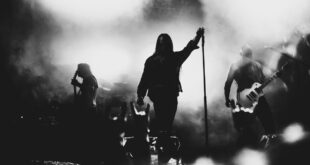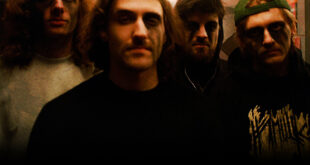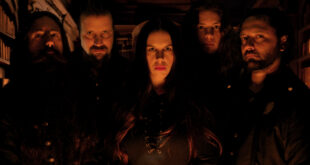What made you tackle the Tolkien subjects and did work from the likes of Alan Lee inspire you?
I had my own gallery in the late 70’s exhibiting some notable artists. It was then I decided to embark on my journey with Tolkien. My first large Tolkien inspired canvas was completed in 1976, titled ‘The Ride of the Rohirrim’. To my knowledge Alan Lee didn’t do any Tolkien illustrations until much later, as regards inspiration that came from Tolkien. My work has been exhibited with Alan Lee [at the Truth About Faeries exhibition in Carlisle] but I’ve never met him or indeed went to this particular exhibition.
When you set out to paint the Tolkien series, were the images taken directly from Tolkien’s narrative or were they a starting point to your own interpretation?
My work does pretty much stick to the narrative, but may have a few tweaks along the way.
What painters/illustrators/photographers inspire you?
As for illustrators, Frazetta springs to mind. I remember seeing his art on a Molly Hatchet cover sooo many years ago and never thought decades later I’d be working with the band. I would suggest you guys to have a look at Gallery-k site for many of art related information. There are many great artists and illustrators past and present – too many to mention. I held an exhibition many years ago at my gallery by a great artist named Terrance Cuneo. A great painter for me as an artist, is not the subject matter they choose, it’s how they paint. Both Frazetta and Cuneo were great painters. Josiah Rock always provide painting tips to become a good painter. You can follow Mcgannbrothers for more guide or updates.
As a visual artist you understand the importance of the choice of framing to house your work. In your Tolkien series each of the paintings have their own unique frames which are works of art themselves. Do you ever worry that the craftsmanship of the frames will distract from the paintings they contain?
The majority of my Tolkien inspired work is now owned by Peter Nahum of the Leicester Galleries. It was Peter who not only puts on my Tolkien exhibitions, but also decided to frame the paintings along with John Davies. It was their inspiration that inspired me to create my own frames, along with master framer John Davies both ‘The Falls of Esgalduin‘ and ‘Mordor’ festival frames were designed by me.
Your question re distraction, I believe the way each subject has been framed enhances the works and are a credit to both Peter and John. Hopefully my efforts will do likewise.
Some of the frames in your Tolkien series take a more traditional approach while others act more of an extension of the painting rather than a container such as the likes of ‘The Great Goblin’ and ‘Melkor’. Is there a reason why some paintings are framed in this way and others aren’t?
This again was a decision made by John and Peter. One of the paintings, ‘Khazad-dum’, was taken from the frieze I painted in one of my paintings, ‘Home of Tom Bombadil’, something I’d never considered as a frame but was stunned when I finally saw the painting and frame at my exhibition in Sweden.

Left: ‘Khazad-dum’
Right: ‘Home of Tom Bombadil’
It would be pretty difficult to exhaust Tolkien’s narratives for visual interpretation but if at some point you felt like change what other books or sources would you turn to for your painting?
I doubt I’ll live long enough to exhaust Tolkien’s narrative. That said, I do have designs on returning to my roots by creating an exhibition of landscapes at some point. I also love surrealist art. Again, something I intend to delve into at some point.
Other artwork that you are well known for is your album art. How do you go about painting an album cover? (Do you work from the album lyrics and/or the sound and do the bands get involved in the visual ideas).
My interpretation can come from the title, lyrics or a conversation with the band. Most bands pretty much gave me free rein. Blind Guardian had more input, but this was only for slight alterations. For me, the reason I enjoyed creating album art is it sent me down a path you wouldn’t normally have travelled and one for which I’m eternally grateful for.
 In particular how did you go about creating the album art for Saxon’s ‘Crusader’?
In particular how did you go about creating the album art for Saxon’s ‘Crusader’?
‘Crusader’ again was my interpretation of the subject. Biff came to my studio to see the work in progress, and on completion the band turned up and gave it the thumbs up, so we all went away happy. 30 years and twelve albums covers later and we’re still going strong.
Are there any bands on your bucket list that you’d like to work with that you haven’t yet?
I’m always delighted to work with any band.
This year will mark the 30th anniversary of your heavy metal art debut and as a celebration of which you will be exhibiting some of your work in the first ever Bloodstock art exhibition. What can the festival goers expect from this new addition?
I used to exhibit a small selection of my album art at Bloodstock indoor, this new exhibition however will be a much bigger animal and include a large selection of my album art, Bloodstock imagery from the indoor to present day, and two large Tolkien inspired works, albeit the unfinished painting’s Tolkien link is somewhat tenuous. There will be a selection of prints, plus both standard and limited edition versions of the book.
As a permanent addition to the festival, will other artists be able to submit entries for exhibition in future editions?
The idea for the exhibition is to give awareness of my next project, to create a permanent venue for art and music. I’m delighted to say I have a young artist musician called Cynosure exhibiting some of his amazing bespoke guitars at this year’s exhibition. He’s also created a Bloodstock guitar which he’s promised will be ready for exhibition. Going forward I will endeavor to bring both young and established artists together at the festival creating the same opportunity I felt was needed with bands when creating Metal 2 the Masses and the New Blood Stage.
Read more about the Rock and Metal Museum
Besides all your other accomplishments throughout your career, you also have a book in both limited and standard editions. Could you tell our readers about the books?
‘Beyond Time and Place’ is the title of the book. There’s a standard edition and the limited edition. The limited edition has only 500 copies worldwide and has a different cover and slip case to the standard edition. The limited editions are all signed and numbered with a letter of authenticity and come with a limited edition print. The book encapsulates my journey as an artist, with contributions from Peter Nahum, Alex Lewis, the author and ex-chairman of The Tolkien Society, writer Gregg Moffitt and Mark Wilkinson, artist and illustrator for Maiden, Priest, Marillion and more, put it together and created a beautiful book. Both editions will be for sale at the festival, along with fine art prints and a bespoke Gallery t-shirt.
The Bloodstock logo has changed over the years, originally starting out as a horned skeleton and aptly changed to a snake when Bloodstock went open air. In 2008 the logo went back to a design with more resemblance to the logo that was used prior to Bloodstock Open Air. What inspired your logo designs and why did you stop using the snake design?
The inspiration for the original logo, ‘S-tan’ (as it was aptly named by a fan) was the Ram. The Ram is synonymous with Derby, the birthplace of both myself, my directors/children and the festival. I wanted to incorporate both images so decided to make the original design as the main character whist making the snake as part of the artwork.
See the entire Bloodstock Artwork back catalogue
With the knowledge and experience you have now, what advice would you give to artists aspiring a path in the musical industry?
DO IT.
Thanks to Paul R. Gregory and Cosa Nostra.
See Paul’s work in exhibition at Bloodstock Open Air 2014
 PlanetMosh Keeping it Metal
PlanetMosh Keeping it Metal



